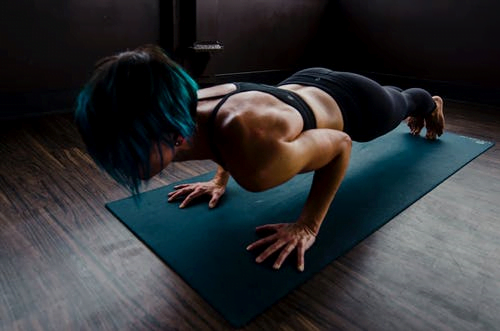With gyms and sporting facilities still being closed, we’re all currently destined to take control of our own training. We may struggle with knowing what to do or find ourselves stuck in a routine of doing the same things over and over. This blog explores a few of the options for at-home/outdoor training at this time which may just help you to shake things up a little and challenge your body and mind in new ways.
Circuit training – This is a popular choice for classes and lone workouts alike. Circuits typically include a number of different exercises that are repeated one after the other for a certain number of rounds or length of time. It can incorporate several different exercises including both cardiovascular and strength work and due to this variety it rarely gets boring. You shouldn’t be spending too long on any one exercise and you can incorporate new and different exercises each time you train to keep things interesting and to make sure you’ve got a good all-round fitness program going on during these times. You may wish to focus each session such as upper body one day, lower another and cardiovascular exercises another or you might incorporate several or all of these into one session. The possibilities are endless!
Straight sets/reps – This is something you can incorporate into circuit training or any resistance based workout. This could also be applied to some cardiovascular exercises such as star jumps or skipping with a rope. You would set yourself a number of reps to complete in one set and then rest before completing the next set and repeat this as many times as you choose. You can also perform a certain number of sets and reps of one exercise (e.g. 3 sets of 15 reps of bicep curls) before moving straight on to a different exercise (such as tricep dips) and rest after this and then repeat a similar pattern several times. You should rest between sets of the same exercise, whereas with circuit training you may jump straight into the next exercise if it involves different muscle groups. Look out for a later blog or speak to an exercise professional for details on how many sets and reps of an exercise suits you and your goals.

Training for time – This can also be incorporated into a circuit session or can be used for other exercises such as running, walking and cycling. You may set yourself a total length for the session such as 20 or 30 minutes and exercise as much as possible in that time. During a circuit workout, the length of the intervals can be allocated in time for example instead of doing X amount of reps of an exercise, you do as many reps as possible (AMRAP) in an interval such as 30, 40 or 60 seconds. You may then allocate a certain time period for rest before repeating the exercise or moving on to the next. Setting a time limit for your workout such as 10 minutes can be a great motivational tool if you’re just getting started or are finding excuses not to complete workouts at the moment as you know how long it’s going to take before you even begin therefore the end is firmly in sight! Short sessions may also feel more manageable and therefore create a great sense of achievement when you complete them as opposed to those longer workouts many of us never find enough time for! Over time, you may increase the total length of your exercise session or increase the length of the intervals you spend on each exercise and/or reduce rest periods.
Another slightly more creative way of utilising time in a workout is to do certain exercises every minute on the minute (EMOM). You would set yourself a sequence of exercises to complete and then rest until the timer hits a full minute and then start again. The longer the exercises take to complete, the less rest you get. You could repeat this for a certain length of time e.g. 10 minutes or you may wish to continue until you’re tired and try and increase the number of round you can complete as you progress.

Pyramid training – Typically used with resistance exercises, pyramid training is where you complete a larger number of reps at a lighter weight and decrease the number of reps as you increase your weight to work ‘up the pyramid.’ You may then reverse the pattern as you decrease your weights and increase reps. This can also be done with just one weight if you’re new to training and find that completing several sets of an exercise at the same number of reps is too difficult. Try completing one set of 12 reps, the next of 10, then 8 and so on. It’s a great way of really challenging one area or muscle group. The principal of pyramid training can also be used when training with time by completing an exercise for a certain number of seconds such as 40 and then resting, then going again for 10 seconds less, then again for 10 seconds less and so on. You could make the exercises more intense or energetic as you are performing them for a shorter amount of time to challenge your body in new ways.
Training for distance – This could be done with a piece of indoor equipment if you have one such as a static bike, treadmill or rower. It can also be done outdoors with an exercise such as cycling, jogging or walking. Set yourself a distance you’d like to cover (this could be in miles/kilometres or less specific such as 3 laps of your local park) and note down how long it takes you to complete that distance. Over time, you may be able to complete the same distance in a quicker time or with less rest or you may wish to increase the distance you cover as you progress. There are many simple devices such as watches and apps that can track distance for you if you want to explore this option.

Outdoor training – Last but not least, if you find yourself stuck at home constantly following sessions on a screen or making up a routine alone, you may well start to suffer from a bit of cabin fever! Outdoor training has a great number of benefits as part of a balanced exercise program such as getting some fresh air and vitamin D, challenging yourself with natural landmarks such as hills and seeing other people out and about to smile and wave to! If you feel stuck in a rut and caged within the same four walls, try getting out and exploring somewhere new! If you’re keen on learning more about local walks in Rawtenstall and the surrounding areas – look out for next week’s blog!
*Please speak to an exercise professional if you are unsure if any of these options are suitable for you and look out for future blogs for further details and tips on training.
Beverley Meakin – Personal Trainer/Exercise Referral Officer and Complementary Therapist. Instagram @bevs_life

